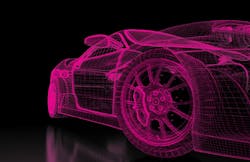This Week's Top Advanced Vehicle Design News
May 5, 2021—According to the Society of Automotive Engineers (SAE), “Adaptive Driving Beam" is a “long-range forward visibility beam that adapts to the presence of opposing and preceding vehicles by modifying portions of its beam pattern to avoid glare above lower beam photometry levels to the drivers of opposing and preceding vehicles."
The goal of the system is to improve long-range visibility for the driver without causing discomfort, distraction, or glare to other road users.
In recent years, both Europe and Japan have begun to allow adaptive beam headlighting systems as optional equipment. However, Federal Motor Vehicle Safety Standard (FMVSS) No. 108, which regulates automotive lighting, signaling, and reflective devices in the United States, currently does not address this type of adaptive front-lighting system that does not switch between upper and lower beams.
In 2013, Toyota submitted a petition to NHTSA to initiate rulemaking to amend FMVSS No. 108, to permit the use of an advanced forward lighting design called “adaptive high-beam system (AHS)” on motor vehicles.
As a result, in 2015 NHTSA conducted and released research about the systems and the existing European test procedures:
“Overall in these tests, ADB was shown to have the ability to dynamically adapt the headlamp beams to shade oncoming and preceding vehicles. However, in many cases, ADB illuminance levels exceeded that of lower beam mode in the location of other vehicles. In particular, tested ADB systems exceeded derived lower beam glare limit values in curve scenarios involving both the ADB-equipped vehicle and other vehicle moving, and in intersection scenarios. Some ADB systems were also unable to control glare to lower beam levels in scenarios involving a motorcycle.
“This effort was successful in objectively assessing the performance of European ADB headlighting systems. A comprehensive objective test procedure was achieved. The test procedure was developed based on driving scenarios from the ECE R48 test procedure and incorporated use of the glare limit values derived from existing static beam pattern requirements of FMVSS No. 108. Existing FMVSS No. 108 requirements and the work summarized here together can provide a basis for performance criteria and an objective test procedure for ADB headlighting systems. Existing FMVSS No. 108 requirements and the work summarized here together can provide a basis for objective performance criteria and an objective test procedure for assessing ADB headlighting system performance.”
Despite the report and comments that the agency hoped to finalize the ruling in 2020, and the issue remains in the “Final Rule Stage”. ADAPT has reached out to NHTSA for an update and timeline.
Besides automakers such as Audi, BMW and Toyota, industry organizations such as AAA have joined the call and previously submitted comments to NHTSA regarding the proposed changes.
